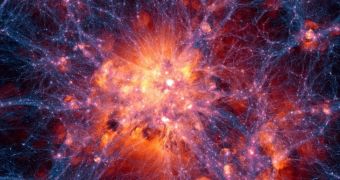Just yesterday, brainiacs with MIT (the Massachussets Institute of Technology) went public with the news that, together with other scientists, they had successfully created a realistic virtual universe that they say is the first of its kind.
The simulation recreates 13 billion years of cosmic evolution in a cube whose sides span over 350 million light-years, and the folks behind this project say that the resolution of their model is unprecedented.
This computer model is said to cover a region of the universe that is big enough to be representative of the entire cosmos, and detailed enough to allow scientists to study small-scale structures and gain a better understanding of them.
“With this model, we are able to get agreement with observational data on small scales and large scales,” researcher Mark Vogelsberger says in a statement.
“Until now, no single simulation was able to reproduce the universe on both large and small scales simultaneously,” the scientist goes on to comment on the importance of this achievement.
In a paper published in the journal Nature, the scientists who worked on this initiative, dubbed the Illustris project, explain that their model follows the evolution of visible and dark matter starting 12 million years after the Big Bang.
When it reaches present day, i.e. over 13 billion years later, the cube of simulated space encompasses more than 41,000 galaxies, some of which are spiral like the Milky Way and some of which are football-shaped elliptical ones.
What's more, the simulation recreates structures such as galaxy clusters, and bubbles and voids that are part and parcel of the cosmic void, specialists explain.
“Some galaxies are more elliptical and some are more like the Milky Way, [spiral] disc-type galaxies. There is a certain ratio in the universe. We get the ratio right. That was not achieved before,” Mark Vogelsberger with MIT wishes to stress.
This so-called universe in a cube created by MIT scientists and fellow researchers also reproduces how different elements are distributed. Of these elements, two very important ones are the hydrogen and helium that made up the early universe, and others are heavier ones that go into planet formation.
According to Mark Vogelsberger, the success of this endeavor is due to improved algorithms and the fact that the model takes into account a wide variety of physics laws and notions.
The model is so complex that the computing power needed to run it is nothing short of impressive. Thus, it is said that, if run on a state-of-the-art desktop computer, it would take 2,000 years, and that, even when run across over 8,000 processors, it took several months to complete.
Check out the two videos below to learn more about this project and catch a glimpse of what this universe in a cube is all about.

 14 DAY TRIAL //
14 DAY TRIAL // 
